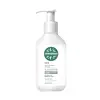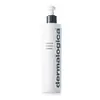What's inside
What's inside
 Key Ingredients
Key Ingredients

 Benefits
Benefits

 Concerns
Concerns

 Ingredients Side-by-side
Ingredients Side-by-side

Water
Skin ConditioningDisodium Cocoamphodiacetate
CleansingCarthamus Tinctorius Seed Oil
MaskingGlycerin
HumectantCocamidopropyl Betaine
CleansingCaprylyl Glycol
EmollientAcrylates/C10-30 Alkyl Acrylate Crosspolymer
Emulsion StabilisingPanthenol
Skin ConditioningSesamum Indicum Seed Oil
EmollientCaprylic/Capric Triglyceride
MaskingStearic Acid
CleansingAvena Sativa Kernel Flour
AbrasiveXanthan Gum
EmulsifyingAminomethyl Propanol
BufferingCaprylhydroxamic Acid
Rosa Canina Fruit Oil
EmollientTocopherol
AntioxidantCetearyl Alcohol
EmollientGlycine Soja Oil
EmollientBeta-Glucan
Skin ConditioningSodium Hyaluronate Crosspolymer
HumectantCitric Acid
BufferingWater, Disodium Cocoamphodiacetate, Carthamus Tinctorius Seed Oil, Glycerin, Cocamidopropyl Betaine, Caprylyl Glycol, Acrylates/C10-30 Alkyl Acrylate Crosspolymer, Panthenol, Sesamum Indicum Seed Oil, Caprylic/Capric Triglyceride, Stearic Acid, Avena Sativa Kernel Flour, Xanthan Gum, Aminomethyl Propanol, Caprylhydroxamic Acid, Rosa Canina Fruit Oil, Tocopherol, Cetearyl Alcohol, Glycine Soja Oil, Beta-Glucan, Sodium Hyaluronate Crosspolymer, Citric Acid
Water
Skin ConditioningGlycerin
HumectantCaprylic/Capric Triglyceride
MaskingSodium Cocoyl Isethionate
CleansingSodium Lauroyl Glutamate
Divinyldimethicone/Dimethicone Copolymer
Sodium Astrocaryum Murumuruate
EmollientCeramide NP
Skin ConditioningPhytosterols
Skin ConditioningPalmitic Acid
EmollientStearic Acid
CleansingHydrogenated Coconut Acid
EmollientHydrolyzed Cottonseed Protein
Skin ConditioningCitrus Aurantium Dulcis Peel Oil
MaskingTocopherol
AntioxidantXanthan Gum
EmulsifyingDimethicone
EmollientButyrospermum Parkii Butter
Skin ConditioningCarthamus Tinctorius Seed Oil
MaskingC12-13 Pareth-3
EmulsifyingPrunus Amygdalus Dulcis Oil
Skin ConditioningTetrasodium Glutamate Diacetate
Caprylyl Glycol
EmollientCitrus Paradisi Peel Oil
MaskingCitrus Reticulata Leaf Oil
MaskingMyristic Acid
CleansingTrideceth-12
EmulsifyingJasminum Officinale Oil
MaskingLinoleic Acid
CleansingAmyris Balsamifera Bark Oil
MaskingCananga Odorata Flower Oil
MaskingCitrus Limon Peel Oil
MaskingCymbopogon Martini Oil
MaskingEugenia Caryophyllus Leaf Oil
MaskingPelargonium Graveolens Flower Oil
MaskingSalvia Sclarea Oil
MaskingCitrus Limon Fruit Extract
MaskingDecyl Glucoside
CleansingCanarium Luzonicum Gum Nonvolatiles
MaskingCitrus Aurantium Dulcis Flower Oil
AstringentGuaiacum Officinale Wood Oil
MaskingRosa Damascena Flower Oil
MaskingZingiber Officinale Root Oil
MaskingDisodium EDTA
Equisetum Arvense Extract
AstringentHumulus Lupulus Extract
AntimicrobialPinus Sylvestris Cone Extract
MaskingRosmarinus Officinalis Leaf Extract
AntimicrobialHexylene Glycol
EmulsifyingLinolenic Acid
CleansingPentylene Glycol
Skin ConditioningAminomethyl Propanol
BufferingSodium Chloride
MaskingSodium Isethionate
CleansingPropanediol
SolventButylene Glycol
HumectantPolysilicone-11
Sodium Hydroxide
BufferingEthylhexylglycerin
Skin ConditioningAcrylates/C10-30 Alkyl Acrylate Crosspolymer
Emulsion StabilisingPEG-12 Dimethicone
Skin ConditioningLimonene
PerfumingPhenoxyethanol
PreservativeWater, Glycerin, Caprylic/Capric Triglyceride, Sodium Cocoyl Isethionate, Sodium Lauroyl Glutamate, Divinyldimethicone/Dimethicone Copolymer, Sodium Astrocaryum Murumuruate, Ceramide NP, Phytosterols, Palmitic Acid, Stearic Acid, Hydrogenated Coconut Acid, Hydrolyzed Cottonseed Protein, Citrus Aurantium Dulcis Peel Oil, Tocopherol, Xanthan Gum, Dimethicone, Butyrospermum Parkii Butter, Carthamus Tinctorius Seed Oil, C12-13 Pareth-3, Prunus Amygdalus Dulcis Oil, Tetrasodium Glutamate Diacetate, Caprylyl Glycol, Citrus Paradisi Peel Oil, Citrus Reticulata Leaf Oil, Myristic Acid, Trideceth-12, Jasminum Officinale Oil, Linoleic Acid, Amyris Balsamifera Bark Oil, Cananga Odorata Flower Oil, Citrus Limon Peel Oil, Cymbopogon Martini Oil, Eugenia Caryophyllus Leaf Oil, Pelargonium Graveolens Flower Oil, Salvia Sclarea Oil, Citrus Limon Fruit Extract, Decyl Glucoside, Canarium Luzonicum Gum Nonvolatiles, Citrus Aurantium Dulcis Flower Oil, Guaiacum Officinale Wood Oil, Rosa Damascena Flower Oil, Zingiber Officinale Root Oil, Disodium EDTA, Equisetum Arvense Extract, Humulus Lupulus Extract, Pinus Sylvestris Cone Extract, Rosmarinus Officinalis Leaf Extract, Hexylene Glycol, Linolenic Acid, Pentylene Glycol, Aminomethyl Propanol, Sodium Chloride, Sodium Isethionate, Propanediol, Butylene Glycol, Polysilicone-11, Sodium Hydroxide, Ethylhexylglycerin, Acrylates/C10-30 Alkyl Acrylate Crosspolymer, PEG-12 Dimethicone, Limonene, Phenoxyethanol
Ingredients Explained
These ingredients are found in both products.
Ingredients higher up in an ingredient list are typically present in a larger amount.
Acrylates/C10-30 Alkyl Acrylate Crosspolymer is a synthetic polymer. It is used to thicken and improve the texture of products. Due to its properties, it can prevent water and oil ingredients from separating.
Aminomethyl Propanol is used to adjust the pH of products. It is also used as a base to create other organic compounds. Having a balanced pH is important for protecting your skin.
Aminomethyl propanol is safe to use in cosmetics up to 1%. It is soluble in water.
This ingredient is an emollient, solvent, and texture enhancer. It is considered a skin-softener by helping the skin prevent moisture loss.
It helps thicken a product's formula and makes it easier to spread by dissolving clumping compounds.
Caprylic Triglyceride is made by combining glycerin with coconut oil, forming a clear liquid.
While there is an assumption Caprylic Triglyceride can clog pores due to it being derived from coconut oil, there is no research supporting this.
Learn more about Caprylic/Capric TriglycerideCaprylyl Glycol is a humectant and emollient, meaning it attracts and preserves moisture.
It is a common ingredient in many products, especially those designed to hydrate skin. The primary benefits are retaining moisture, skin softening, and promoting a healthy skin barrier.
Though Caprylyl Glycol is an alcohol derived from fatty acids, it is not the kind that can dry out skin.
This ingredient is also used as a preservative to extend the life of products. It has slight antimicrobial properties.
Learn more about Caprylyl GlycolCarthamus tinctorius seed oil comes from safflower, one of humanity's oldest crops.
Safflower seed oil contains a high percentage of linoleic acid and oleic acid. It also contains Vitamin E. These three components are effective moisturizers.
Vitamin E helps nourish your skin's lipid barrier. It is also a potent antioxidant. Antioxidants help fight free-radical molecules, or unstable molecules that may damage your skin cells.
Due to its high fatty acid content, this ingredient may not be malassezia folliculitis safe.
Thoughout history, safflower has been used for dying fabrics and in food as a saffron substitute.
Learn more about Carthamus Tinctorius Seed OilGlycerin is already naturally found in your skin. It helps moisturize and protect your skin.
A study from 2016 found glycerin to be more effective as a humectant than AHAs and hyaluronic acid.
As a humectant, it helps the skin stay hydrated by pulling moisture to your skin. The low molecular weight of glycerin allows it to pull moisture into the deeper layers of your skin.
Hydrated skin improves your skin barrier; Your skin barrier helps protect against irritants and bacteria.
Glycerin has also been found to have antimicrobial and antiviral properties. Due to these properties, glycerin is often used in wound and burn treatments.
In cosmetics, glycerin is usually derived from plants such as soybean or palm. However, it can also be sourced from animals, such as tallow or animal fat.
This ingredient is organic, colorless, odorless, and non-toxic.
Glycerin is the name for this ingredient in American English. British English uses Glycerol/Glycerine.
Learn more about GlycerinStearic Acid is a fatty acid. It is an emollient, emulsifier, and texture enhancer.
As an emollient, stearic acid helps soften skin. It aids the skin's protective barrier by preventing water loss. It also provides a gentle cleansing effect without stripping away natural oils.
Stearic acid may also be used to enhance the texture of products. It can add volume and stabilize ingredients such as water and oil. This can help water and oil ingredients from separating.
Sources of stearic acid include animal or vegetable fats/oils such as coconut or shea. It can be naturally found in butter, cocoa butter, shea butter, vegetable fats, and animal tallow.
This ingredient may not be Malassezia folliculitis, or fungal-acne safe.
Learn more about Stearic AcidTocopherol (also known as Vitamin E) is a common antioxidant used to help protect the skin from free-radicals and strengthen the skin barrier. It's also fat soluble - this means our skin is great at absorbing it.
Vitamin E also helps keep your natural skin lipids healthy. Your lipid skin barrier naturally consists of lipids, ceramides, and fatty acids. Vitamin E offers extra protection for your skin’s lipid barrier, keeping your skin healthy and nourished.
Another benefit is a bit of UV protection. Vitamin E helps reduce the damage caused by UVB rays. (It should not replace your sunscreen). Combining it with Vitamin C can decrease sunburned cells and hyperpigmentation after UV exposure.
You might have noticed Vitamin E + C often paired together. This is because it is great at stabilizing Vitamin C. Using the two together helps increase the effectiveness of both ingredients.
There are often claims that Vitamin E can reduce/prevent scarring, but these claims haven't been confirmed by scientific research.
Learn more about TocopherolWater. It's the most common cosmetic ingredient of all. You'll usually see it at the top of ingredient lists, meaning that it makes up the largest part of the product.
So why is it so popular? Water most often acts as a solvent - this means that it helps dissolve other ingredients into the formulation.
You'll also recognize water as that liquid we all need to stay alive. If you see this, drink a glass of water. Stay hydrated!
Learn more about WaterXanthan gum is used as a stabilizer and thickener within cosmetic products. It helps give products a sticky, thick feeling - preventing them from being too runny.
On the technical side of things, xanthan gum is a polysaccharide - a combination consisting of multiple sugar molecules bonded together.
Xanthan gum is a pretty common and great ingredient. It is a natural, non-toxic, non-irritating ingredient that is also commonly used in food products.
Learn more about Xanthan Gum